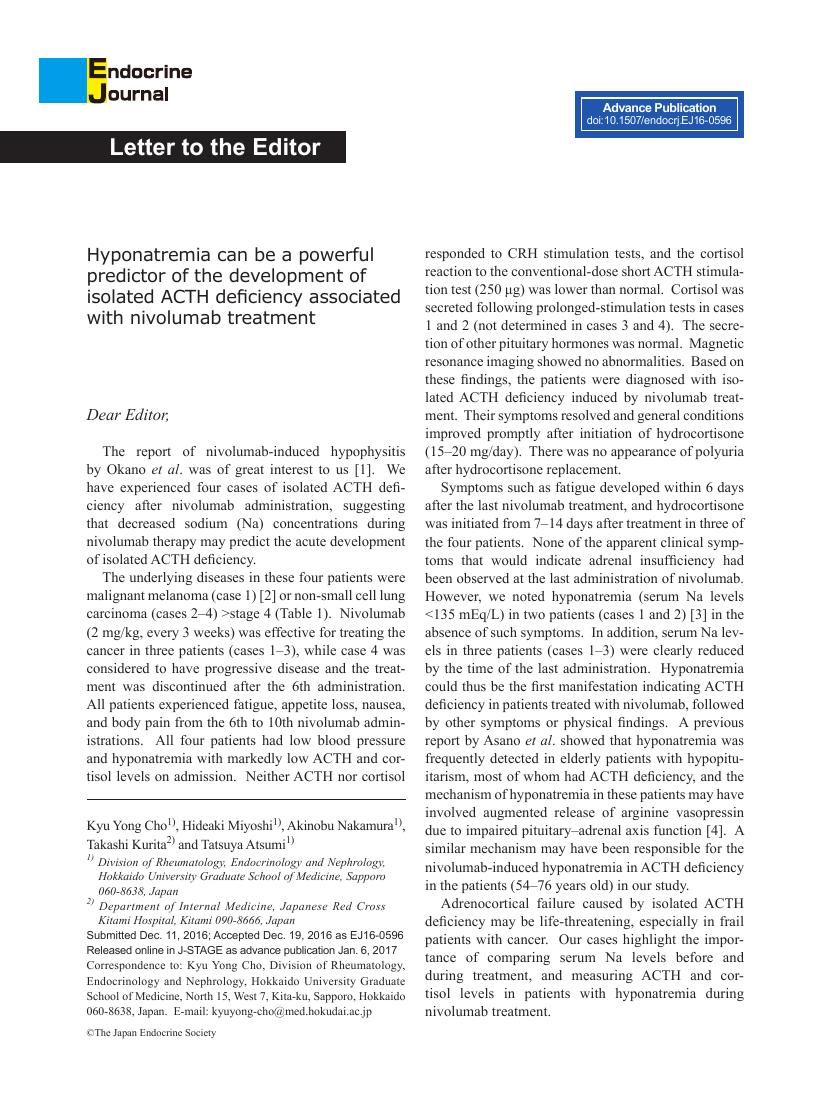- 著者
- Kyu Yong Cho Hideaki Miyoshi Akinobu Nakamura Takashi Kurita Tatsuya Atsumi
- 出版者
- (社)日本内分泌学会
- 雑誌
- Endocrine Journal (ISSN:09188959)
- 巻号頁・発行日
- pp.EJ16-0596, (Released:2017-01-06)
- 被引用文献数
- 33
- 著者
- Chiho Oba-Yamamoto Hiraku Kameda Hideaki Miyoshi Tomonori Sekizaki Takahiro Takase Tsuyoshi Yanagimachi Yukihiro Fujita Hiroshi Nomoto Kyu Yong Cho Akinobu Nakamura So Nagai Tatsuya Atsumi
- 出版者
- The Japanese Society of Internal Medicine
- 雑誌
- Internal Medicine (ISSN:09182918)
- 巻号頁・発行日
- vol.60, no.15, pp.2375-2383, 2021-08-01 (Released:2021-08-01)
- 参考文献数
- 23
- 被引用文献数
- 1
Objective Glucose-dependent insulinotropic polypeptide (GIP) is speculated to worsen growth hormone (GH) hypersecretion in acromegaly and to be a cause of paradoxical increases in GH (PI-GH) during 75-g oral glucose tolerance testing (75-g OGTT). Dipeptidyl peptidase-4 inhibitors (DPP4is), which increase the circulating concentration of active GIP, are frequently administered to diabetic patients, including those with acromegaly. We aimed to determine whether or not the administration of a DPP4i increases GH concentration, especially in patients demonstrating PI-GH during a DPP4i-OGTT, in which a DPP4i was administered immediately before 75-g OGTT. Methods This prospective cross-sectional study was carried out on acromegalic patients admitted to Hokkaido University hospital between June 2011 and May 2018. The participants underwent both 75-g OGTT and DPP4i-OGTT. For those who underwent surgery, immunohistochemical staining and quantitative polymerase chain reaction (PCR) for the GIP receptor (GIPR) were performed on the resected pituitary adenomas. Results Twenty-five percent of the participants had PI-GH confirmed (3 of 12 cases). Two of the three participants who demonstrated PI-GH exhibited higher circulating GH concentrations during DPP4i-OGTT than during OGTT. The increase in plasma glucose was reduced during DPP4i-OGTT compared to during 75-g OGTT, suggesting that the increase in GH during DPP4i-OGTT was due not to high glucose concentrations but instead increased GIP caused by the administration of DPP4i. The adenoma from one participant with PI-GH displayed positive immunostaining for GIPR and a higher GIPR messenger ribonucleic acid (mRNA) expression than the others. Conclusion DPP4i may enhance the GH secretion response during glucose loading, especially in individuals with PI-GH.
1 0 0 0 OA Safety and tolerability of diazoxide in Japanese patients with hyperinsulinemic hypoglycemia
- 著者
- Yumiko Komatsu Akinobu Nakamura Masahiro Takihata Yuichiro Inoue Satoko Yahagi Kazuki Tajima Hirohisa Tsuchiya Tatsuro Takano Tadashi Yamakawa Masahiro Yoshida Hideaki Miyoshi Yasuo Terauchi
- 出版者
- (社)日本内分泌学会
- 雑誌
- Endocrine Journal (ISSN:09188959)
- 巻号頁・発行日
- vol.63, no.3, pp.311-314, 2016 (Released:2016-03-31)
- 参考文献数
- 11
- 被引用文献数
- 2 14
Diazoxide is a non-diuretic benzothiadiazine derivative, one of a group of substances introduced into clinical practice in the 1950s for the treatment of hypertension. Fajans reported the use of diazoxide for the treatment of insulinoma in 1979. Although patients with hyperinsulinemic hypoglycemia worldwide have been treated with diazoxide for more than 30 years, there are no recent reports about the adverse effects of this drug in Asian patients, including Japanese patients. Herein, we report the results of our retrospective clinical record review of 6 Japanese patients (3 females and 3 males, ranging in age from 58 to 91 years) with hyperinsulinemic hypoglycemia and inoperable insulinoma treated with diazoxide. Diazoxide improved control of hypoglycemic symptoms and maintained normoglycemia in 5 of the 6 patients, and was ineffective in one patient. Surprisingly, although all 6 patients received diazoxide according to the treatment strategy recommended in Western patients, 5 of the 6 patients developed edema and two developed congestive heart failure. Thus, when starting treatment with diazoxide in Japanese patients, the symptoms and signs of fluid retention should be evaluated carefully. Also, appropriate protocols for treatment with diazoxide should be evaluated by means of clinical trials in Japanese patients with hyperinsulinemic hypoglycemia.
